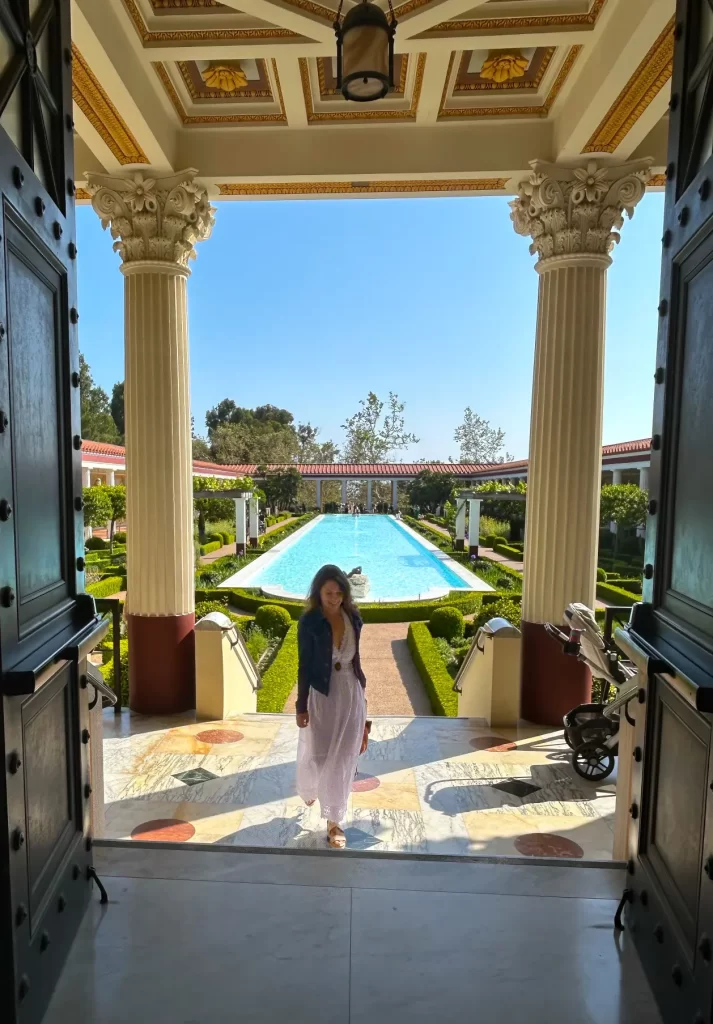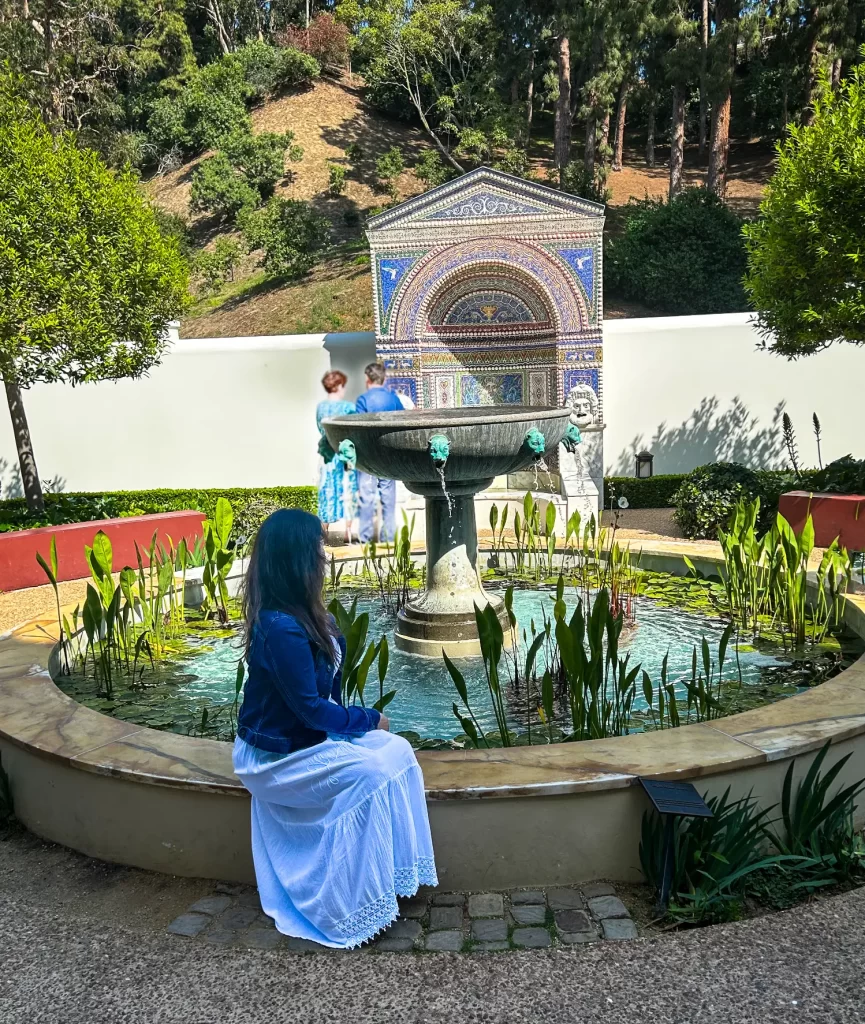Welcome to our Full Guide to 1 Lovely Day at The Getty Villa.
Located in the picturesque hills of Pacific Palisades, the Getty Villa showcases a unique journey through ancient Rome right in the heart of California. From its stunning architecture inspired by a Roman country house to its vast collection of antiquities, the Getty Villa is a must-visit for art lovers, history enthusiasts, and anyone seeking a tranquil escape.

Table of Contents
ToggleLooking for a Full Guide to 1 Lovely Day At The Getty Villa?
In this blog post, we’ll explore the history, architecture, art collections, and visitor tips to help you make the most of your visit to the Getty Villa.
Website for Both, The Getty Center and The Getty Villa http://www.getty.edu/
A Glimpse Of History
The Getty Villa opened its doors in 1974, conceived by oil magnate J. Paul Getty, Getty’s vision was to create a space that would replicate the grandeur of the Villa of the Papyri in Herculaneum, a site buried by the eruption of Mount Vesuvius in 79 AD.
The Getty Villa houses Getty’s extensive collection of Greek, Roman, and Etruscan art, and also serves as an educational center dedicated to collecting more information about the ancient world.
The Getty Villa reopened in 2006 with expanded gallery spaces and new educational facilities after undergoing significant renovations, cementing its status as a premier institution for appreciating and understanding classical antiquity.

Architectural Marvel
The Outer Peristyle
Walking through the Getty Villa is like stepping back in time. The design is a meticulous recreation of an ancient Roman country house, complete inside gardens with peristyles, gardens, and fountains.
The Outer Peristyle, the stunning garden is surrounded by a colonnaded walkway that features a long reflecting pool, lush greenery, and beautiful sculptures, offering a serene environment for a pleasant stroll, this is a remarkable space that captures the essence of ancient Roman luxury and elegance.
As you walk through the covered walkway supported by columns pathways and admire the intricate sculptures and lush greenery, you’ll gain a deeper appreciation for the timeless beauty of ancient Roman culture. As you stroll through the hallways, you feel you are in another place far away from California.
the Inner Peristyle
The Inner Peristyle is a more intimate garden space captivating a blend of art with intricate mosaics and plantings, it reflects the types of flora found in ancient Roman gardens, it provides insights into the daily life and aesthetics of the ancient Romans.
It is modeled after the peristyle gardens found in affluent Roman homes. These gardens served as private retreats for relaxation and socializing, surrounded by covered walkways and decorated with sculptures, fountains, and plants.
Key features of the Inner Peristyle include an Enclosed Garden framed by several columns in a cover pathway allowing you to enjoy the garden’s beauty.
Another key feature is the Central rectangular pool at the heart of the Inner Peristyle, the pool’s serene water surface adds a reflective quality to the space, enhancing the sense of calm and contemplation.
The floors of the walkways are adorned with intricate mosaics, replicas of ancient Roman designs. These mosaics add an element of historical authenticity and artistic sophistication to the garden.
the Herb Garden
The Herb Garden, showcasing plants used in ancient Roman cooking and medicine, is a delightful and aromatic space that provides an immersive experience into the botanical practices of ancient Rome.
The garden is carefully designed to reflect the structure and aesthetics of ancient Roman herb gardens, some key aspects are the symmetrical beds, a common feature in Roman gardens that allowed for easy cultivation and harvesting of herbs.
Gravel paths wind through the garden beds, allowing you to stroll and closely examine the plants. These paths also enhance the garden’s accessibility and aesthetics.
Some herbs are grown in raised planters, which helps with drainage and provides an elevated view of the plants.
In the garden, there is a large variety of plants used by the Romans for culinary, medicinal, and ornamental purposes.
Herbs were key in Roman cuisine, used to flavor dishes, preserve food, and make herbal teas. The variety of herbs in the garden showcases the flavors that would have been common in Roman kitchens.
Herbs also held religious and symbolic significance. For instance, bay laurel was associated with the god Apollo and used in religious ceremonies and as a symbol of triumph.
Many herbs in the garden were used for their healing properties. Romans utilized these plants to treat various ailments, reflecting their sophisticated knowledge of natural remedies.
Some notable plants include:
Lavender is known for its soothing fragrance and use in oils and perfumes. Rosemary, used for cooking, was also believed to improve memory. Sage is valued for its medicinal properties and culinary uses. Thyme, a common herb in Roman cuisine and medicine, is known for its antiseptic properties. Fennel was used both as a vegetable and for its seeds, which have medicinal benefits. Bay Laurel leaves were used in cooking and to make laurel wreaths, symbolizing victory and honor.

Art Collections & Exhibits AT The Getty Villa
The Getty Villa boasts an impressive collection of over 44,000 antiquities spanning 7,000 years of ancient history, focusing on the classical civilizations of Greece, Rome, and Etruria.
Step into History with the Permanent collection and special exhibits.
As part of the Permanent Collection they showcase Statues and Sculptures built with marble and Bronze that portray gods, heroes, and everyday people from ancient times.
The collection also showcases busts of emperors, philosophers, and significant figures providing insight into the people who shaped ancient history. Relief sculptures illustrate mythological scenes, historical events, and daily activities.
They also have a collection of Pottery and Vases illustrating the daily life, myths, and legends of ancient Greece and Rome. The Greek Pottery collection features a wide variety of Greek pottery, including red-figure and black-figure vases, kylixes (drinking cups), amphorae (storage jars), and kraters (mixing bowls). These pieces often describe intricate scenes from mythology, daily life, and athletic competitions.
The Villa houses stunning Roman frescoes that once decorated the walls of Roman villas. These artworks provide a glimpse into the luxurious interiors of ancient homes, featuring vibrant colors and detailed scenes.
The collection includes intricate floor and wall mosaics depicting geometric patterns, mythological scenes, and everyday life. These mosaics reflect the skill and creativity of ancient artists.
Jewelry and Glassware, the craftsmanship of ancient artisans through delicate jewelry and exquisitely crafted glass objects.
In addition to the permanent collection, the Villa hosts special exhibits that offer deeper insights into specific aspects of ancient cultures. You can always find the current special exhibit by checking their website when you plan to visit.
More To Know About The Getty Villa

Planning your visit to the Getty Villa is easy, admission is free but you would need to make a reservation in advance to get in. This helps manage visitor flow and ensures a pleasant experience for all. The villa is open from Wednesday to Monday, from 10 a.m. to 5 p.m. For Tickets: http://www.getty.edu/visit/villa/
Parking is $25 but if you visit the Getty Center, let’s say during the morning they give you a free parking entry ticket for the Getty Villa if you plan to visit both museums on the same day.
If you plan to visit the Getty Villa on the weekend or during rush hour, be sure to allow extra time because the Pacific Coast Highway (PCH) can be slow. It took us almost an hour to drive from the Santa Monica Pier to the Getty Villa on PCH on a Sunday. However, if you’re driving from the Getty Center, the trip is probably easier.
The Getty Villa regularly hosts special exhibits that delve into specific themes, regions, or periods of ancient history. These temporary exhibits provide deeper insights into ancient cultures and often include rare artifacts on loan from other institutions.
In addition to the permanent and special exhibits, the Getty Villa offers several educational and interactive displays designed to enhance the whole experience. Especially if you have kids, this is a super cute adventure for them besides how educative could be for them.
The Family Forum is an interactive area that provides hands-on activities for visitors of all ages. It’s an excellent way for families to engage with the art and history of the ancient world.
The Villa offers audio guides and mobile apps that provide detailed information about the collections and exhibits, allowing visitors to explore at their own pace, also you can get different guided tours at the Getty.
At the Getty Villa Museum and also at the Getty Center, they usually have numbers under the piece of art that you are admiring, add the number into the app and it tells you all you need to know about that specific piece of art you are looking into.
I added a picture of the app at the bottom just in case you would like to add it to your phone. This is a super cool feature that it’s great to have.
If you are staying during lunch hours, they have a cafe where you can grab a bite, The café offers a variety of dishes inspired by Mediterranean cuisine, including salads, sandwiches, and pasta. There are also vegetarian and gluten-free options available.
They also offer outdoor seating. Their hours are from 11:00 a.m. to 4:00 p.m. Even though reservations are not necessary, it can get busy during lunchtime.
If you prefer, you can grab a quick bite to go and enjoy it in one of the garden areas.

The Most Famous Art Pieces at The Getty Villa in Pacific Palisades
The Lansdowne Herakles
One of the most celebrated sculptures in the collection, the Lansdowne Herakles is a Roman marble statue that depicts the Greek hero Herakles (Hercules) in a moment of repose. This statue exemplifies the idealized forms and heroic themes prevalent in classical art.
The Victorious Youth
This rare bronze statue of an athlete, also known as the Getty Bronze, is a masterpiece of ancient Greek art. It captures the dynamic energy and realism that Greek sculptors achieved in their portrayal of the human form.
The Herculaneum Women
These elegant statues of women from the ancient town of Herculaneum, buried by the eruption of Mount Vesuvius, offer a glimpse into the fashion and aesthetics of the Roman elite.

Frequently Asked Questions
How long should you spend at Getty Villa?
You could see everything in 2 hours, but if you are planning on taking a guided tour or staying for lunch at the cafe, I would suggest allowing 4 hours.
Is There A Dress Code for the Museum?
There is no formal dress code for visiting the Getty Villa. However, it’s a good idea to dress comfortably and wear appropriate footwear, as you will likely be walking through gardens and galleries. Since the Villa is both an indoor and outdoor venue, consider bringing a hat and sunscreen for sun protection, as well as a light jacket or sweater if the weather is cool. Dressing in layers can help ensure you’re comfortable throughout your visit.
Can I visit the Getty Center and The Getty Villa on the same day?
Yes. It’s better because you save on parking fees. They give you a free pass to the Getty Villa if you Visit the Getty Center on the same day.
Is Getty Villa worth it?
Yes! First of all, it’s free and it’s gorgeous. It makes a great family outing. I would advise you to try to visit any other day than Sunday to escape the crowds and traffic.

Conclusion
The Getty Villa’s art collections and exhibits provide a refined exploration of the ancient world. From iconic sculptures and complex pottery to luxurious jewelry and vivid frescoes, the Villa offers a unique opportunity to experience the art and culture of classical antiquity, plus the chance to admire the gorgeous Gardens and pools around the building.
I love visiting the Getty Center and The Getty Villa with my family. These trips always brighten our days and leave us feeling enriched and inspired.

If you liked the Getty Villa, you’ll love The Getty Center as well, feel free to check out our latest Blog Post “How to Spend 1 Beautiful Day at The Getty Center” on our Blog page.

